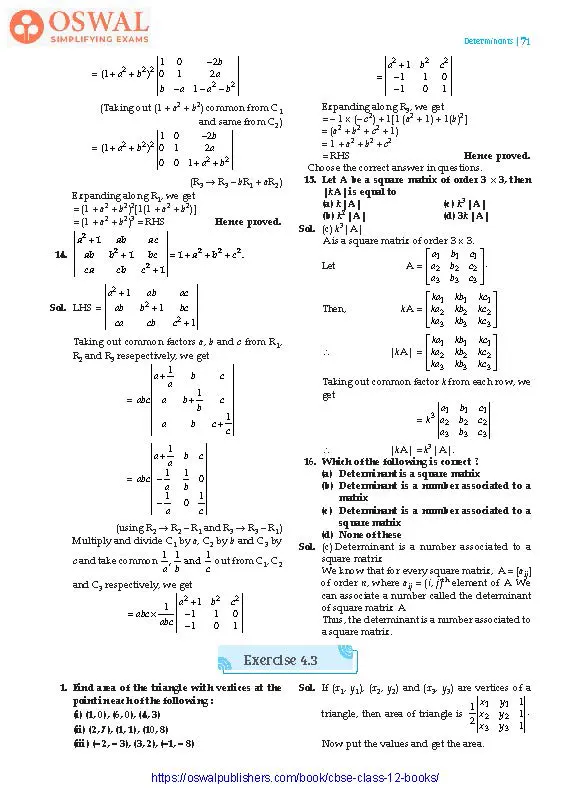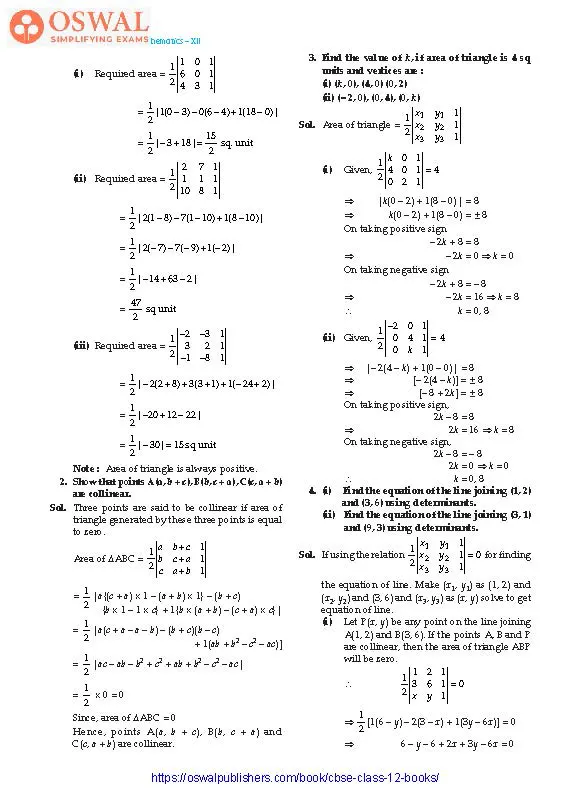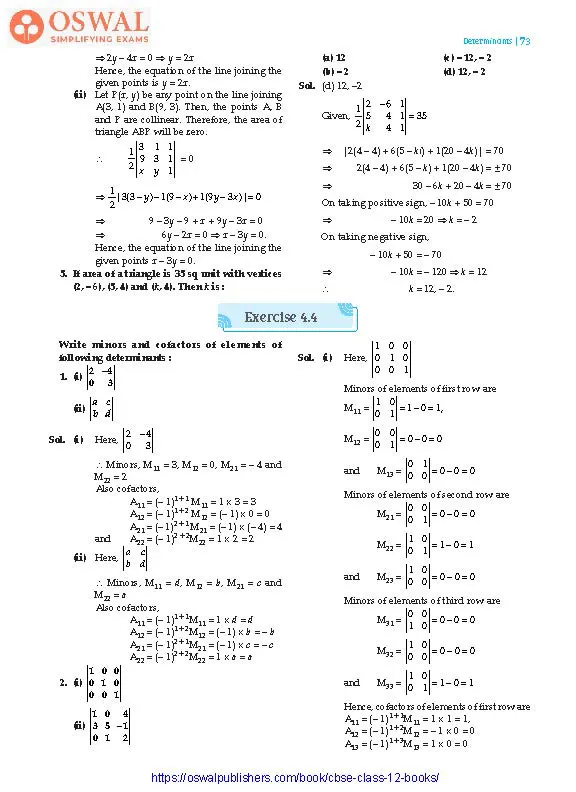NCERT Solutions for Class 12 Maths Chapter 4 Determinants - Exercise 4.3



Access Exercises of Class 12 Maths Chapter 4 –Determinants
Exercise 4.1 Solutions: 8 Questions (2 Long, 5 Short Answers, 1 MCQ)
Exercise 4.2 Solutions: 16 Questions(7 Long, 7 Short, 2 MCQs)
Exercise 4.3 Solutions: 5 Questions ( 4 Short Answers, 1 MCQ)
Exercise 4.4 Solutions: 5 Questions (4 Long, 1 MCQ)
Exercise 4.5 Solutions: 18 Questions (11 Long, 5 Short, 2 MCQs)
Exercise 4.6 Solutions: 16 Questions (13 Long, 3 Short)
Miscellaneous Exercise Solutions: 19 Questions (15 Long, 1 Short, 3 MCQs)
Exercise 4.3
1. Find area of the triangle with vertices at the point in each of the following :
(i) (1, 0), (6, 0), (4, 3)
(ii) (2, 7), (1, 1), (10, 8)
(iii) (– 2, – 3), (3, 2), (–1, – 8)
Sol. If (x1, y1), (x2, y2) and (x3, y3) are vertices of a triangle, then area of triangle is
$$\frac{1}{2}\begin{vmatrix}x_{1} &y_{1} &1\\x_{2} &y_{2} &1\\x_{3} &y_{3} &1\end{vmatrix}.$$
Now put the values and get the area.
$$\textbf{(i) Required area =}\\\space\frac{1}{2}\begin{vmatrix}1 &0 &1\\6 &0 &1\\4 &3 &1\end{vmatrix}\\=\frac{1}{2}\lbrack1(0-3)-0(6-4)\\+ 1(18-0)\rbrack\\=\frac{1}{2}|-3+18|=\frac{15}{2}\space\text{sq. unit}$$
$$\textbf{(ii)\space} \text{Required area} \\=\frac{1}{2}\begin{vmatrix}2 &7 &1\\1 &1 &1\\10 &8 &1\end{vmatrix}\\=\frac{1}{2}\begin{vmatrix}2(1-8)-7(1-10) +1(8-10)\end{vmatrix}\\=\frac{1}{2}|2(\normalsize-7)-7(\normalsize-9)+1(\normalsize-2)|\\=\frac{1}{2}|-14+63-2|\\=\frac{47}{2}\space\text{sq unit}$$
$$\textbf{(iii)\space}\text{Required area =}\\\frac{1}{2}\begin{vmatrix}-2 &-3 &1\\ 3 &2 &1\\\normalsize-1 &-8 &1\end{vmatrix}\\=\frac{1}{2}|-2(2+8)+3(3+1)\\+1(-24+2)|\\=\frac{1}{2}|-20+12-22|\\=\frac{1}{2}|-30| = 15\space\text{sq unit}$$
Note : Area of triangle is always positive.
2. Show that points A(a, b + c), B(b, c + a), C(c, a + b) are collinear.
Sol. Three points are said to be collinear if area of triangle generated by these three points is equal to zero.
Area of ΔABC
$$=\frac{1}{2}\begin{vmatrix}a &b+c &1\\b &c+a &1\\c &a+b &1\end{vmatrix}\\=\frac{1}{2}\begin{vmatrix}a\lbrace(c+a)×1 - (a+b)×1\rbrace -\\(b+c)\lbrace b×1-1×c\rbrace\\+1\lbrace b×(a+b) - (c+a)×c\rbrace\end{vmatrix}\\=\frac{1}{2}\lbrace a(c+a-a-b)-(b+c)(b-c)\\+1(ab+b^{2}-c^{2}-ac)\rbrace\\=\frac{1}{2}\begin{vmatrix}\text{ac - ab- b}^{2}+c^{2}+ab+\\b^{2}-c^{2}-ac\end{vmatrix}\\=\frac{1}{2}×0=0$$
Since, area of ΔABC = 0
Hence, points A(a, b + c), B(b, c + a) and C(c, a + b) are collinear.
3. Find the value of k, if area of triangle is 4 sq units and vertices are :
(i) (k, 0), (4, 0) (0, 2)
(ii) (– 2, 0), (0, 4), (0, k)
$$\textbf{Sol.}\space \text{Area of triangle =}\\\frac{1}{2}\begin{vmatrix}x_{1} &y_{1} &1\\x_{2} &y_{2} &1\\x_{3} &y_{3} &1\end{vmatrix}\\\textbf{(i)\space}\text{Given,}\space\frac{1}{2}\begin{vmatrix}k &0 &1\\4 &0 &1\\0 &2 &1\end{vmatrix}=4\\\Rarr\begin{vmatrix}k(0-2) + (8-0)\end{vmatrix}=8\\\Rarr\space k(0-2)+1(8-0) = \pm8 $$
On taking positive sign
– 2k + 8 = 8
⇒ – 2k = 0 ⇒ k = 0
On taking negative sign
– 2k + 8 = – 8
⇒ – 2k = 16 ⇒ k = 8
∴ k = 0, 8
$$\text{(ii)\space}\text{Given,}\frac{1}{2}\begin{vmatrix}\normalsize-2 &0 &1\\0 &4 &1\\0 &k &1\end{vmatrix}\\=4\\\Rarr\space \begin{vmatrix}-2(4-k)+1(0-0)\end{vmatrix}\\=8\\\Rarr\space \lbrack-2(4-k)\rbrack\\=\pm \space8\\\Rarr\space\lbrack-8+2k\rbrack =\pm\space 8$$
On taking positive sign,
2k – 8 = 8
⇒ 2k = 16 ⇒ k = 8
On taking negative sign,
2k – 8 = – 8
2k = 0 ⇒ k = 0
∴ k = 0, 8
4. (i) Find the equation of the line joining (1, 2) and (3, 6) using determinants.
(ii) Find the equation of the line joining (3, 1) and (9, 3) using determinants.
Sol. If using the relation
$$\frac{1}{2}\begin{vmatrix}x_{1} &y_{1} &1\\x_{2} &y_{2} &1\\x_{3} &y_{3} &1\end{vmatrix} = 0$$
for finding the equation of line. Make (x1, y1) as (1, 2) and (x2, y2) and (3, 6) and (x3, y3) as (x, y) solve to get equation of line.
(i) Let P(x, y) be any point on the line joining A(1, 2) and B(3, 6). If the points A, B and P are collinear, then the area of triangle ABP will be zero.
$$\therefore\space\frac{1}{2}\begin{vmatrix}1 &2 &1\\3 &6 &1\\x &y &1\end{vmatrix}= 0\\\Rarr\frac{1}{2}\lbrack1(6-y)-2(3-x)+\\1(3y-6x)\rbrack=0\\\Rarr\space 6-y-6+2x+3y-6x=0\\\Rarr\space 2y-4x=0\\\Rarr\space y=2x$$
Hence, the equation of the line joining the given points is y = 2x.
(ii) Let P(x, y) be any point on the line joining A(3, 1) and B(9, 3). Then, the points A, B and P are collinear. Therefore, the area of triangle ABP will be zero.
$$\therefore\space \frac{1}{2}\begin{vmatrix}3 &1 &1\\9 &3 &1\\x &y &1\end{vmatrix}=0\\\Rarr\space\frac{1}{2}\begin{vmatrix}3(3-y)-1(9-x)+\\1(9y-3x)\end{vmatrix}= 0\\\Rarr\space 9-3y-9+x+9y-3x=0\\\Rarr\space 6y-2x=0\\\Rarr\space x-3y = 0.$$
Hence, the equation of the line joining the given points x – 3y = 0.
5. If area of a triangle is 35 sq unit with vertices (2, – 6), (5, 4) and (k, 4). Then k is :
(a) 12
(b) – 2
(c) – 12, – 2
(d) 12, – 2
Sol. (d) 12, –2
$$\text{Given,\space}\frac{1}{2}\begin{vmatrix}2 &-6 &1\\5 &4 &1\\ k &4 &1\end{vmatrix}=35\\\Rarr\space \begin{vmatrix}2(4-4) +\\ 6(5-ki) + 1(20-4k)\end{vmatrix}=70\\\Rarr\space 2(4-4) +6(5-k)+ 1(20-4k)\\=\pm70\\\Rarr\space 30-6k+20-4k=\pm70$$
On taking positive sign, – 10k + 50 = 70
$$\Rarr\space -10k =20\\\Rarr\space k =-2$$
On taking negative sign,
– 10k + 50 = – 70
$$\Rarr\space -10k =-120\\\Rarr\space k=12\\\therefore\space k=12,-2.$$
Share page on
NCERT Solutions Class 12 Mathematics
- Chapter 1 Relations and Functions
- Chapter 2 Inverse Trigonometric Functions
- Chapter 3 Matrices
- Chapter 4 Determinants
- Chapter 5 Continuity and Differentiability
- Chapter 6 Application of Derivatives
- Chapter 7 Integrals
- Chapter 8 Applications of the Integrals
- Chapter 9 Differential Equations
- Chapter 10 Vectors
- Chapter 11 Three-Dimensional Geometry
- Chapter 12 Linear Programming
- Chapter 13 Probability
CBSE CLASS 12 NCERT SOLUTIONS
- NCERT Solutions Class 12 English Core
- NCERT Solutions Class 12 Physics
- NCERT Solutions Class 12 Chemistry
- NCERT Solutions Class 12 Biology
- NCERT Solutions Class 12 Business Studies
- NCERT Solutions Class 12 Mathematics
- NCERT Solutions Class 12 Accountancy
- NCERT Solutions Class 12 Economics
- NCERT Solutions Class 12 Geography
- NCERT Solutions Class 12 History
- NCERT Solutions Class 12 Political Science
CBSE CLASS 12 SYLLABUS
- CBSE Class 12 English core Syllabus
- CBSE Class 12 Mathematics Syllabus
- CBSE Class 12 Physics Syllabus
- CBSE Class 12 Chemistry Syllabus
- CBSE Class 12 Biology Syllabus
- CBSE Class 12 Accountancy Syllabus
- CBSE Class 12 Business Studies Syllabus
- CBSE Class 12 Economics Syllabus
- CBSE Class 12 History Syllabus
- CBSE Class 12 Geography Syllabus
- CBSE Class 12 Political science Syllabus
- CBSE Class 12 Sociology Syllabus
- CBSE Class 12 Psychology Syllabus
- CBSE Class 12 Physical education Syllabus
- CBSE Class 12 Applied mathematics Syllabus
- CBSE Class 12 History of Indian Arts Syllabus
CBSE CLASS 12 Notes
- CBSE Class 12 Physics Notes
- CBSE Class 12 Chemistry Notes
- CBSE Class 12 Biology Notes
- CBSE Class 12 Maths Notes
- CBSE Class 12 Accountancy Notes
- CBSE Class 12 Business Studies Notes
- CBSE Class 12 Economics Notes
- CBSE Class 12 History Notes
- CBSE Class 12 Geography Notes
- CBSE Class 12 Political Science Notes

